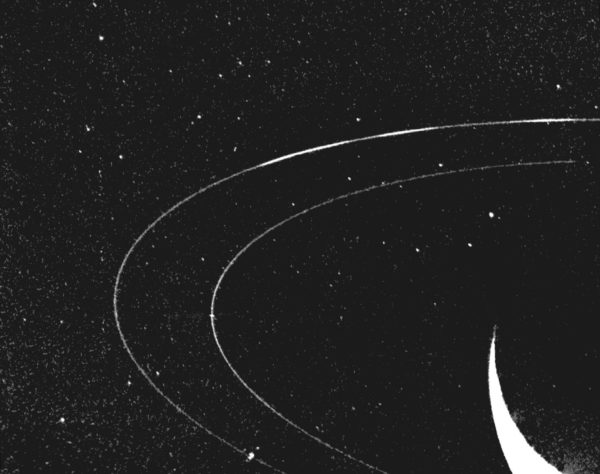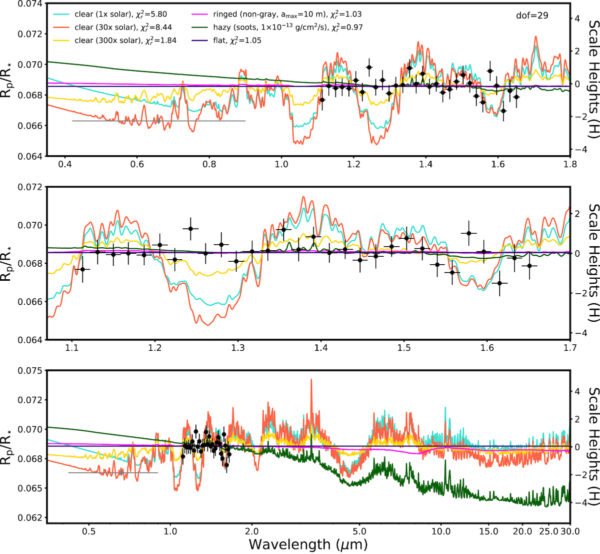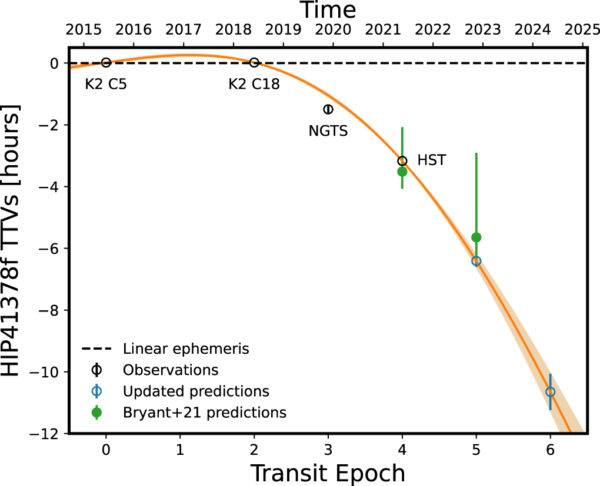AAS Nova reports on a “super-puff” exoplanet that’s nearly 15 times less dense than Jupiter.
Astronomers have discovered a curious exoplanet with an extremely low bulk density — nearly 15 times less dense than Jupiter and 60 times less dense than Earth. The first spectrum of this planet’s atmosphere gives clues to the cause of this unusual quality.

NASA Exoplanet Catalog
An Exceptional Exoplanet
HIP 41378 f is one of the least dense exoplanets known, floating in at just 0.09 grams per cubic centimeter, but it’s not yet clear why this planet is so loosely packed. HIP 41378 f might be an example of a rare class of exoplanets called super-puffs, which contain far more gas than expected given their masses. On the other hand, the planet’s low bulk density could be just a trick of the light curve — if the planet has rings, its radius might appear artificially large, deflating its calculated bulk density.

Both possibilities are exciting, since we’ve only discovered a handful of super-puff planets, and we’ve yet to definitively detect rings around an exoplanet. Now, a team led by Munazza Alam (Carnegie Earth & Planets Laboratory and Center for Astrophysics | Harvard & Smithsonian) has collected the first near-infrared transmission spectrum of HIP 41378 f’s atmosphere to gain a better understanding of this unusual planet.

Alam et al. 2022
Puffy Planet, Rocky Rings, or Something Else?
Alam and collaborators used the Hubble Space Telescope to measure the light that filters through HIP 41378 f’s atmosphere as the planet makes its 19-hour transit across the face of its parent star. The team found that HIP 41378 f’s spectrum is nearly featureless, lacking the characteristic dips that signal absorption of light by molecules in the atmosphere.
Using one-dimensional atmospheric models, the authors were able to rule out a clear atmosphere rich in hydrogen and helium. However, they found that the planet’s nearly flat spectrum is consistent with multiple scenarios: HIP 41378 f might have an atmosphere exceptionally rich in elements heavier than helium, a layer of haze, or rings. In the ringed planet case, the authors calculated that HIP 41378 f’s true radius would be about 60% smaller than the current estimate, leading to a bulk density of 1.2 grams per cubic centimeter, which is roughly the density of Jupiter and Uranus.
Transit Opportunities
HIP 41378 f’s lack of spectral features doesn’t mean we can’t learn more about the planet’s atmosphere. Measuring the planet’s transmission spectrum at longer wavelengths might help distinguish between the possibilities, since a hazy atmosphere would induce transits of different depths at different wavelengths, while the presence of rings would produce less variation.

Alam et al. 2022
The authors explored the possibility of observing HIP 41378 f with JWST and found that the telescope’s infrared instruments are sensitive enough to distinguish between the competing scenarios. With an orbital period of roughly 1.5 Earth years, there will only be a few opportunities to catch HIP 41378 f transiting in front of its parent star during JWST’s planned five-year mission. Alam and collaborators used the timing of the transit they observed to update the prediction for HIP 41378 f’s future transits; late 2022 and mid 2024 will bring new opportunities to study this enticing faraway world!
References
“The First Near-infrared Transmission Spectrum of HIP 41378 f, A Low-mass Temperate Jovian World in a Multiplanet System,” Munazza K. Alam et al 2022 ApJL 927 L5. doi:10.3847/2041-8213/ac559d
This post originally appeared on AAS Nova, which features research highlights from the journals of the American Astronomical Society.
 1
1









Comments
Rod
March 15, 2022 at 8:44 am
Good report on HIP 41378 f and paper cited. I did some more digging into properties for the exoplanet listed at these sites. https://exoplanetarchive.ipac.caltech.edu/overview/HIP%2041378%20f#planet_HIP-41378-f_collapsible, and http://exoplanet.eu/catalog/hip_41378_f/
Some more tweaking may be needed 🙂 The properties for HIP 41378 f in the paper and eu exoplanet site are not consistent or period, 324 days for the eu site (as well as NASA site) and 542 days for the paper cited. Using host star mass 1.15 Msun, HIP 41378 f mass, 3.775722E-02 Mjup, e=0, P = 542 days, I calculate a = 1.5 au, P = 546 days. In 1 Gyr, 6.6895E+08 revolutions could be completed or about 669 million around the host star. Using the MMSN and applying to 1.15 Msun star, a postulated protoplanetary disk 3.829034E+03 or about 3829 earth masses. http://exoplanet.eu/catalog/ does not list mass properties for exoplanets shown at HIP 41378 star. Given the mass of 12 earth masses and radius 9.2 earth radii listed for HIP 41378 f, this could be like a Uranus size or a bit smaller planet orbiting its host star where Mars is at in our solar system.
You must be logged in to post a comment.
You must be logged in to post a comment.